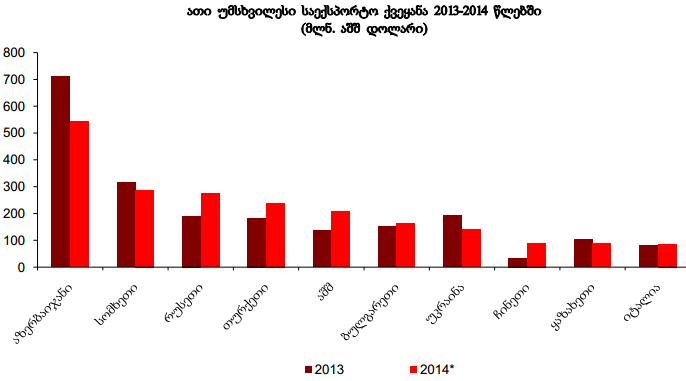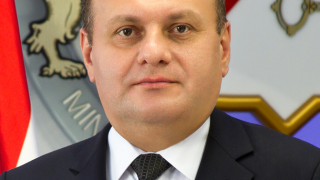On 14 November 2014, at a Parliamentary session, Nodar Khaduri stated that private investments increased by 36% in the first half of 2014. He also added that the amount of loans disbursed in agriculture doubled as compared to 2013 and increased five times as compared to 2012.
FactCheck decided to verify Mr Khaduri’s statement.
The Minister of Finance is referring to domestic investments (not Foreign Direct Investment) in his statement comprising investments made by state or private investors on the territory of Georgia. Investments significantly affect the GDP of a country as the invested amounts are spent generally on opening new factories, expanding existing ones and updating technology. State investments are mostly expenditures of a state for infrastructural projects which facilitate the country’s economic activity.
In the first half of last year, the total amount of investments made in Georgia amounted to GEL 3,766 million, exceeding the previous year by 32%. As for private investments, their volume amounted to GEL 3,418 million in the first half of 2014 whilst this amount was equal to GEL 2,603 million in the same period of 2013. Therefore, investments grew by 31% in the first half of 2014. However, it should be considered that private investments decreased by 9.3% in 2013 as compared to 2012.
Graph 1 shows the structure of the investments made in the country. As the gross investments increase, the share of the state investments decreases. The decrease in state investments is the result of not only the increase in gross investments but the reduction of investment projects made by the state as well. In 2013, state investments decreased by 24% as compared to 2012 whilst they grew by 17% in the first three quarters of 2014 as compared to the same period of 2013.
The decrease in the share of state investments and the leading role of private investments in gross investments is a priority; however, it is noteworthy that state investments are usually expenditures made for infrastructural projects of a common purpose such as the construction of roads, ports, public locations and other objects of common economic importance. The positive effect of the increasing share of private investments should be emphasised as well because the source of these investments is mainly the savings existing in the country. Therefore, an increase in private investments is an indicator of the increase in domestic savings.
Graph 1: Private and State Investments
 Source: National Statistics Office of Georgia
As for agriculture, the Government of Georgia has been implementing various projects for supporting agriculture since 2013. It is noteworthy that these projects have been mainly oriented on the availability of credits in the agricultural sector. According to the data of the National Bank of Georgia, agricultural loans disbursed by commercial banks in the first nine months of 2014 exceeded GEL 198 million. The same index in 2012 amounted to nearly GEL 41 million whilst agricultural loans amounted to more than GEL 94 million in 2013. Therefore, agricultural loans increased twice in 2014 as compared to 2013 and they increased five times as compared to 2012.
It is interesting to note the increase in the number of factories and production in parallel with the increase in loans. In 2013, agriculture grew by 11%, showing a very significant growth. However, in the first three quarters of 2014, the rate of growth for agricultural production shrank to 1.3%. Moreover, the number of agricultural factories according to the six-month data of 2014 totalled 477.
Graph 2: Agriculture
Source: National Statistics Office of Georgia
As for agriculture, the Government of Georgia has been implementing various projects for supporting agriculture since 2013. It is noteworthy that these projects have been mainly oriented on the availability of credits in the agricultural sector. According to the data of the National Bank of Georgia, agricultural loans disbursed by commercial banks in the first nine months of 2014 exceeded GEL 198 million. The same index in 2012 amounted to nearly GEL 41 million whilst agricultural loans amounted to more than GEL 94 million in 2013. Therefore, agricultural loans increased twice in 2014 as compared to 2013 and they increased five times as compared to 2012.
It is interesting to note the increase in the number of factories and production in parallel with the increase in loans. In 2013, agriculture grew by 11%, showing a very significant growth. However, in the first three quarters of 2014, the rate of growth for agricultural production shrank to 1.3%. Moreover, the number of agricultural factories according to the six-month data of 2014 totalled 477.
Graph 2: Agriculture
 Source: National Statistics Office of Georgia
The domestic investments index of the third quarter became known at the end of December 2014. It amounted to GEL 2,280 million and surpassed the same index of the previous year by 26%. In total, domestic investments made in the first nine months of 2014 equalled GEL 6,046 million and exceeded the same nine-month index of 2013 by 30% and the same nine-month index of 2012 by 10%.
Conclusion
In the first half of 2014, gross investments increased by 32% whilst private investments grew by 31%. As for agricultural loans, according to the data of the National Bank of Georgia, nearly GEL 198 million was loaned in the first nine months of 2014 in an amount which is twice as much as the same index of 2013 and five times more than the same index in 2012. However, the growth rate of agricultural production decreased by 1.3% in the first three quarters of 2014 as compared to the same period of the previous year.
It should also be considered that investments decreased in 2013 and if we compare the 2014 data to 2012, the percentage of the growth rate becomes significantly lower.
Therefore, FactCheck concludes that Mr Khaduri’s statement is MOSTLY TRUE.
Source: National Statistics Office of Georgia
The domestic investments index of the third quarter became known at the end of December 2014. It amounted to GEL 2,280 million and surpassed the same index of the previous year by 26%. In total, domestic investments made in the first nine months of 2014 equalled GEL 6,046 million and exceeded the same nine-month index of 2013 by 30% and the same nine-month index of 2012 by 10%.
Conclusion
In the first half of 2014, gross investments increased by 32% whilst private investments grew by 31%. As for agricultural loans, according to the data of the National Bank of Georgia, nearly GEL 198 million was loaned in the first nine months of 2014 in an amount which is twice as much as the same index of 2013 and five times more than the same index in 2012. However, the growth rate of agricultural production decreased by 1.3% in the first three quarters of 2014 as compared to the same period of the previous year.
It should also be considered that investments decreased in 2013 and if we compare the 2014 data to 2012, the percentage of the growth rate becomes significantly lower.
Therefore, FactCheck concludes that Mr Khaduri’s statement is MOSTLY TRUE.
 Source: National Statistics Office of Georgia
As for agriculture, the Government of Georgia has been implementing various projects for supporting agriculture since 2013. It is noteworthy that these projects have been mainly oriented on the availability of credits in the agricultural sector. According to the data of the National Bank of Georgia, agricultural loans disbursed by commercial banks in the first nine months of 2014 exceeded GEL 198 million. The same index in 2012 amounted to nearly GEL 41 million whilst agricultural loans amounted to more than GEL 94 million in 2013. Therefore, agricultural loans increased twice in 2014 as compared to 2013 and they increased five times as compared to 2012.
It is interesting to note the increase in the number of factories and production in parallel with the increase in loans. In 2013, agriculture grew by 11%, showing a very significant growth. However, in the first three quarters of 2014, the rate of growth for agricultural production shrank to 1.3%. Moreover, the number of agricultural factories according to the six-month data of 2014 totalled 477.
Graph 2: Agriculture
Source: National Statistics Office of Georgia
As for agriculture, the Government of Georgia has been implementing various projects for supporting agriculture since 2013. It is noteworthy that these projects have been mainly oriented on the availability of credits in the agricultural sector. According to the data of the National Bank of Georgia, agricultural loans disbursed by commercial banks in the first nine months of 2014 exceeded GEL 198 million. The same index in 2012 amounted to nearly GEL 41 million whilst agricultural loans amounted to more than GEL 94 million in 2013. Therefore, agricultural loans increased twice in 2014 as compared to 2013 and they increased five times as compared to 2012.
It is interesting to note the increase in the number of factories and production in parallel with the increase in loans. In 2013, agriculture grew by 11%, showing a very significant growth. However, in the first three quarters of 2014, the rate of growth for agricultural production shrank to 1.3%. Moreover, the number of agricultural factories according to the six-month data of 2014 totalled 477.
Graph 2: Agriculture
 Source: National Statistics Office of Georgia
The domestic investments index of the third quarter became known at the end of December 2014. It amounted to GEL 2,280 million and surpassed the same index of the previous year by 26%. In total, domestic investments made in the first nine months of 2014 equalled GEL 6,046 million and exceeded the same nine-month index of 2013 by 30% and the same nine-month index of 2012 by 10%.
Conclusion
In the first half of 2014, gross investments increased by 32% whilst private investments grew by 31%. As for agricultural loans, according to the data of the National Bank of Georgia, nearly GEL 198 million was loaned in the first nine months of 2014 in an amount which is twice as much as the same index of 2013 and five times more than the same index in 2012. However, the growth rate of agricultural production decreased by 1.3% in the first three quarters of 2014 as compared to the same period of the previous year.
It should also be considered that investments decreased in 2013 and if we compare the 2014 data to 2012, the percentage of the growth rate becomes significantly lower.
Therefore, FactCheck concludes that Mr Khaduri’s statement is MOSTLY TRUE.
Source: National Statistics Office of Georgia
The domestic investments index of the third quarter became known at the end of December 2014. It amounted to GEL 2,280 million and surpassed the same index of the previous year by 26%. In total, domestic investments made in the first nine months of 2014 equalled GEL 6,046 million and exceeded the same nine-month index of 2013 by 30% and the same nine-month index of 2012 by 10%.
Conclusion
In the first half of 2014, gross investments increased by 32% whilst private investments grew by 31%. As for agricultural loans, according to the data of the National Bank of Georgia, nearly GEL 198 million was loaned in the first nine months of 2014 in an amount which is twice as much as the same index of 2013 and five times more than the same index in 2012. However, the growth rate of agricultural production decreased by 1.3% in the first three quarters of 2014 as compared to the same period of the previous year.
It should also be considered that investments decreased in 2013 and if we compare the 2014 data to 2012, the percentage of the growth rate becomes significantly lower.
Therefore, FactCheck concludes that Mr Khaduri’s statement is MOSTLY TRUE.








